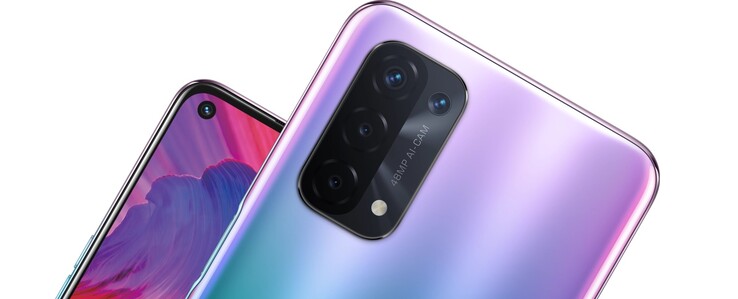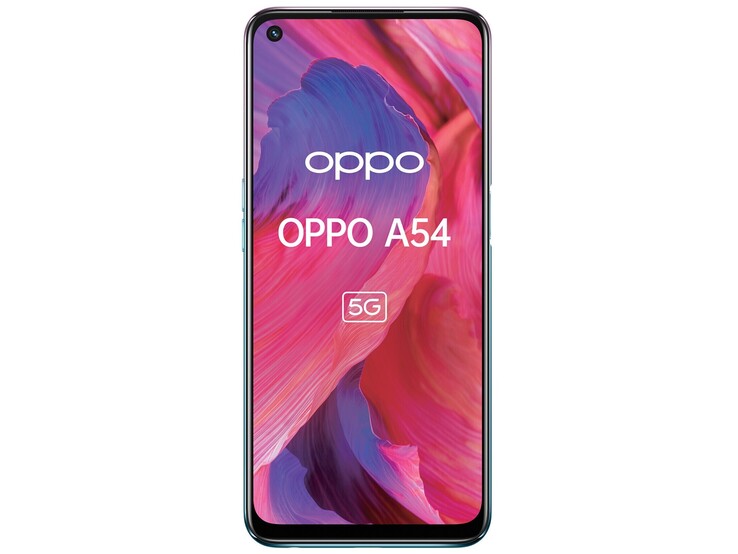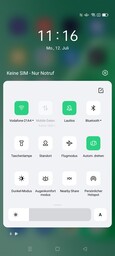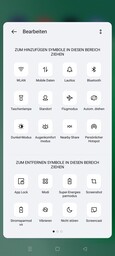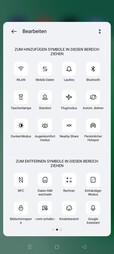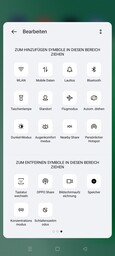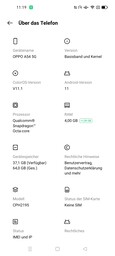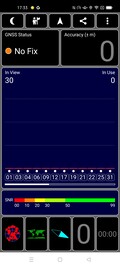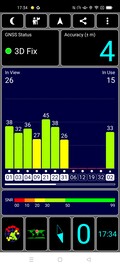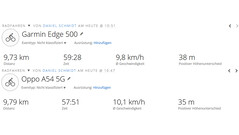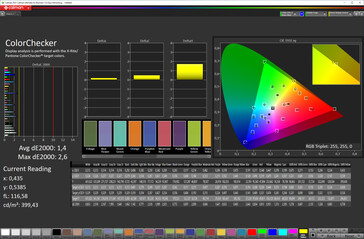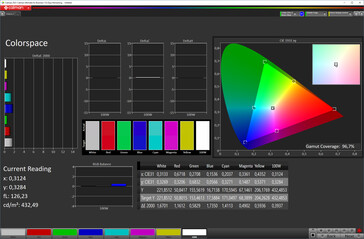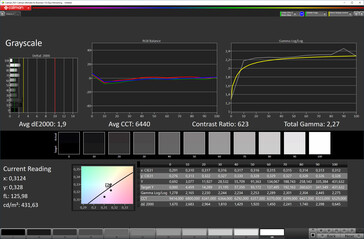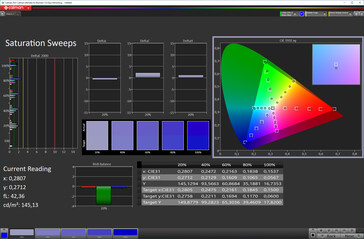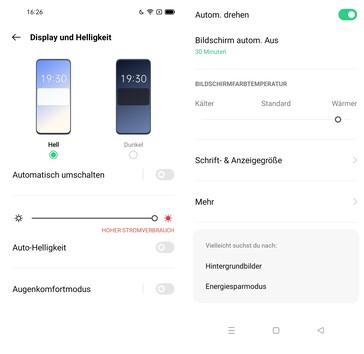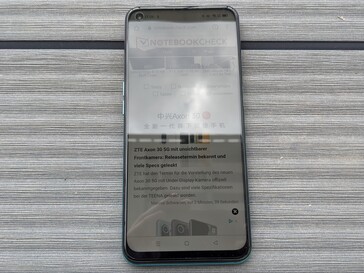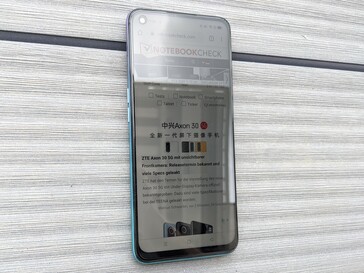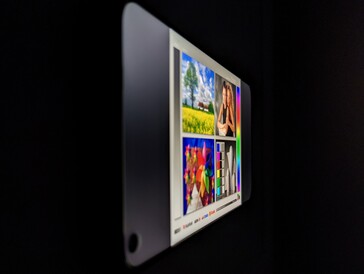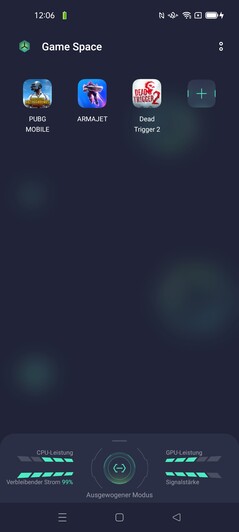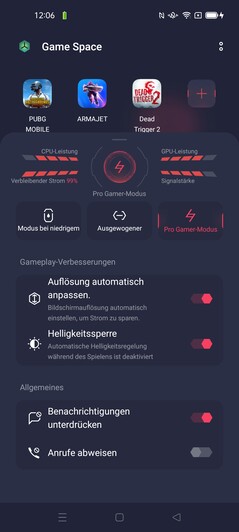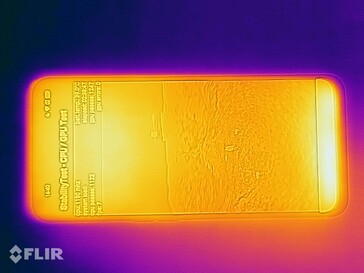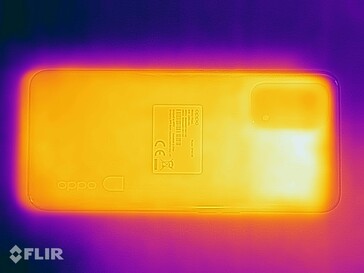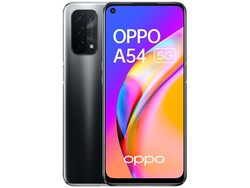Oppo A54 5G smartphone in review: Solid camera in budget 5G phone
Whether it's the A94 5G, the A73 5G, or our current review sample, the A54 5G, Oppo always strives to achieve a good compromise between price, performance, and features. For a price of approximately 270 Euros (~$318), the Oppo A54 5G features a Qualcomm Snapdragon 480 5G with its integrated Adreno 619 for system and graphics performance. In addition, there's 4 GB of RAM and 64 GB of internal storage.
With this equipment, the relatively cheap 5G smartphone has to face the competition listed below. Other smartphones from our database can also be added for comparison under each section.
Possible contenders in comparison
Rating | Date | Model | Weight | Drive | Size | Resolution | Price |
|---|---|---|---|---|---|---|---|
| 80 % v7 (old) | 07 / 2021 | Oppo A54 5G SD 480, Adreno 619 | 190 g | 64 GB UFS 2.1 Flash | 6.50" | 2400x1080 | |
| 80.2 % v7 (old) | 05 / 2021 | Realme 8 5G Dimensity 700, Mali-G57 MP2 | 185 g | 128 GB UFS 2.1 Flash | 6.50" | 2400x1080 | |
| 75.7 % v7 (old) | 06 / 2021 | Samsung Galaxy M12 Exynos 850, Mali-G52 MP1 | 214 g | 64 GB eMMC Flash | 6.50" | 1600x720 | |
| 80.5 % v7 (old) | 07 / 2021 | Xiaomi Poco M3 Pro 5G Dimensity 700, Mali-G57 MP2 | 190 g | 128 GB UFS 2.2 Flash | 6.50" | 2400x1080 | |
| 79.2 % v7 (old) | 07 / 2021 | Motorola Moto G50 SD 480, Adreno 619 | 192 g | 64 GB UFS 2.1 Flash | 6.50" | 1600x720 |
Case - Light 5G smartphone
The Oppo A54 5G features narrow screen bezels and a plastic case. The fingerprint sensor is located on the side, so the back is only distinguished by the rectangular camera element. Fluid Black and Fantastic Purple are offered as colors.
Compared with our review sample, the A54 5G is slightly thinner than the Poco M3 Pro 5G, for example, and its dimensions are almost identical to those of the realme 8 5G. At 190 grams, it's also a rather light smartphone.
Connectivity - Budget 5G phone with audio jack
Besides the aforementioned hardware, the Oppo A54 5G also has a microSD card reader that doesn't block any of the two SIM slots in addition. The latter support VoLTE and VoWLAN. The USB-C port supports the USB 2.0 standard, and a 3.5 mm audio jack is included as well as DRM Widevine L1. The Camera2 API Level 3 is supported.
microSD card reader
With our Toshiba Exceria pro M501 reference memory card, the SD card reader achieves speeds of 33.62 MB/s for copying data. Although this isn't particularly fast, it's better than the rest of our test field.
| SD Card Reader - average JPG Copy Test (av. of 3 runs) | |
| Oppo A54 5G (Toshiba Exceria Pro M501) | |
| Xiaomi Poco M3 Pro 5G (Toshiba Exceria Pro M501) | |
| Motorola Moto G50 (Angelbird V60) | |
Cross Platform Disk Test (CPDT)
Software - ColorOS based on Android
The Oppo A54 5G runs Android 11 with security patches a the level of May 5, 2021. The manufacturer's proprietary ColorOS 11.1 is used as the user interface, and it's very similar to pure Android. However, custom apps are implemented to view photos and for the file explorer, for example.
In addition, the structure of the settings menu has been modified. With Facebook and TikTok, third-party apps are also preinstalled, but they can be easily deleted.
Communication and GNSS - With NFC and Wi-Fi 5
The A54 5G can establish mobile connections over GSM, 3G, LTE, and 5G. The supported bands are very extensive, and up to 800 Mb/s is achieved for downloading data and up to 225 Mb/s for uploading data using LTE Cat. 15.
For communication in close ranges, Oppo's smartphone has NFC, Bluetooth 5.1, and Wi-Fi 5 at its disposal. The latter achieves average speeds of 276 Mb/s for sending data and 312 Mb/s for receiving data in combination with our reference router. This score ranks at the lower end of our test field and is only undercut by the Samsung Galaxy M12.
| Networking | |
| iperf3 transmit AX12 | |
| Realme 8 5G | |
| Motorola Moto G50 | |
| Xiaomi Poco M3 Pro 5G | |
| Oppo A54 5G | |
| Samsung Galaxy M12 | |
| iperf3 receive AX12 | |
| Realme 8 5G | |
| Xiaomi Poco M3 Pro 5G | |
| Motorola Moto G50 | |
| Oppo A54 5G | |
| Samsung Galaxy M12 | |
The A54 5G can make use of GPS, GLONASS, Galileo, BeiDou, and QZSS to determine its location. In combination with the app "GPS Test", the smartphone can achieve a positioning accuracy of up to four meters outdoors.
On our routine bike ride, the distance covered is tracked with an inaccuracy similar to that of our reference device, the Garmin Edge 500.
Telephone and call quality - Clear connection with the A54 5G
Calls can be made on the Oppo A54 5G with Android's standard phone app. The volume is relatively high during calls, and background noise is blocked out well. Users can be understood well on both sides.
Cameras - Good photos with 48 MP
Portraits with a resolution of 16 MP can be taken with the Oppo A54's front-facing camera. Colors look natural with it, and strong contrast differences are balanced well. However, fine details and structures become a bit blurry as soon as lighting is no longer optimal. Color filters and beautification modes can be used to adjust the resulting image.
The main camera has 48 MP for simple pictures plus 2 MP for depth information. This allows taking good pictures of objects in close ranges, and many details as well as vivid colors are offered. Panoramic subjects show similar characteristics but tend to show dark areas in the picture if the illumination is uneven. Ultra wide-angle photos are captured with an 8 MP sensor that also delivers rich colors. But details are only visible when they're clearly separated from the objects around them.
If you want to bring objects closer in the picture, only digital zoom is available. It's definitely functional, and it shows a solid result with objects in the picture being moderately well separated from each other. Under poor lighting conditions, subjects can only be recognized vaguely, and colors are heavily misrepresented. A professional mode is available for the manual adjustment of the image quality, allowing the user to make changes to the ISO, shutter speed, white balance, focus, and brightness settings. A 2 MP macro sensor rounds off the camera setup.
Videos are recorded with a similar quality as in our test pictures. Color filters are also available here, but no professional mode. The available resolutions are 720p and 1080p at 30 fps in each case.
Image comparison
Choose a scene and navigate within the first image. One click changes the position on touchscreens. One click on the zoomed-in image opens the original in a new window. The first image shows the scaled photograph of the test device.
Close-upPanoramaUltra winde-angleZoom (5x)Low-lightThe ColorChecker Passport image shows that the Oppo A54 5G's camera reproduces colors brighter than they should be. The test chart is captured sharply under controlled lighting conditions, but it shows weaknesses in contrast in the lower corners.
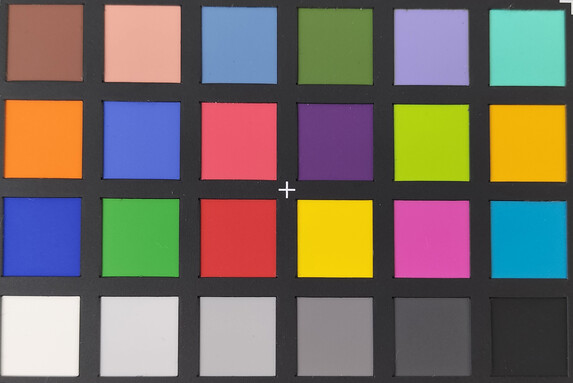

Accessories and warranty - Headset and protective case included in the box
The Oppo A54 5G comes with a USB power adapter with a corresponding USB-C cable, a protective silicone case, a SIM tool, and a stereo headset with a 3.5 mm connector.
The manufacturer states a warranty period of 24 months.
Input devices and handling - Side-mounted fingerprint scanner
Oppo uses Google's GBoard as the keyboard app, which allows inputs without issues. The touchscreen responds reliably to taps and is also suitable for occasional drag-and-drop gestures.
In addition to the good facial recognition, the A54 5G can also be unlocked via the side-mounted fingerprint sensor. It responded quickly to stored fingerprints in the test, and a second attempt was rarely necessary.
Display - Bright and with 90 Hz, but low in contrast
The Oppo A54 5G's screen consists of a 6.5-inch IPS panel and offers a resolution of 2400x1080 pixels. With the brightness sensor enabled, we measured a maximum brightness of 504 cd/m² on average. 438 cd/m² is still reached without the sensor. The minimum brightness is 1.38 cd/m², and the maximum value in the APL50 test is 514 cd/m².
PWM is only used to control brightness at levels below 14% and at a comparatively high frequency of 2,404 Hz.
| |||||||||||||||||||||||||
Brightness Distribution: 95 %
Center on Battery: 498 cd/m²
Contrast: 778:1 (Black: 0.64 cd/m²)
ΔE ColorChecker Calman: 1.4 | ∀{0.5-29.43 Ø4.78}
ΔE Greyscale Calman: 1.9 | ∀{0.09-98 Ø5}
99.9% sRGB (Calman 2D)
Gamma: 2.27
CCT: 6440 K
| Oppo A54 5G IPS, 2400x1080, 6.5" | Realme 8 5G IPS, 2400x1080, 6.5" | Samsung Galaxy M12 IPS, 1600x720, 6.5" | Xiaomi Poco M3 Pro 5G IPS, 2400x1080, 6.5" | Motorola Moto G50 IPS, 1600x720, 6.5" | |
|---|---|---|---|---|---|
| Screen | -63% | -82% | 35% | -49% | |
| Brightness middle (cd/m²) | 498 | 576 16% | 426 -14% | 427 -14% | 340 -32% |
| Brightness (cd/m²) | 504 | 550 9% | 428 -15% | 404 -20% | 325 -36% |
| Brightness Distribution (%) | 95 | 91 -4% | 89 -6% | 87 -8% | 92 -3% |
| Black Level * (cd/m²) | 0.64 | 0.7 -9% | 0.46 28% | 0.17 73% | 0.18 72% |
| Contrast (:1) | 778 | 823 6% | 926 19% | 2512 223% | 1889 143% |
| Colorchecker dE 2000 * | 1.4 | 3.58 -156% | 4.89 -249% | 1.5 -7% | 4.75 -239% |
| Colorchecker dE 2000 max. * | 2.6 | 6.95 -167% | 9.42 -262% | 2.1 19% | 7.53 -190% |
| Greyscale dE 2000 * | 1.9 | 5.7 -200% | 4.8 -153% | 1.6 16% | 3.9 -105% |
| Gamma | 2.27 97% | 2.141 103% | 2.27 97% | 2.3 96% | 2.224 99% |
| CCT | 6440 101% | 7922 82% | 7669 85% | 6652 98% | 7384 88% |
* ... smaller is better
Screen Flickering / PWM (Pulse-Width Modulation)
| Screen flickering / PWM detected | 2404 Hz | ≤ 14 % brightness setting | |
The display backlight flickers at 2404 Hz (worst case, e.g., utilizing PWM) Flickering detected at a brightness setting of 14 % and below. There should be no flickering or PWM above this brightness setting. The frequency of 2404 Hz is quite high, so most users sensitive to PWM should not notice any flickering. In comparison: 53 % of all tested devices do not use PWM to dim the display. If PWM was detected, an average of 8101 (minimum: 5 - maximum: 343500) Hz was measured. | |||
According to our measurements, the contrast ratio of 778:1 and the black level of 0.64 cd/m² are only sufficient for a place at the lower end of our test field. Furthermore, the CalMAN analysis shows that colors are reproduced in the most balanced way when the "Warmer" display profile is selected - alternatively, the "Standard" and "Cooler" variants are also available.
Display Response Times
| ↔ Response Time Black to White | ||
|---|---|---|
| 16.8 ms ... rise ↗ and fall ↘ combined | ↗ 6.8 ms rise | |
| ↘ 10 ms fall | ||
| The screen shows good response rates in our tests, but may be too slow for competitive gamers. In comparison, all tested devices range from 0.1 (minimum) to 240 (maximum) ms. » 37 % of all devices are better. This means that the measured response time is better than the average of all tested devices (20.2 ms). | ||
| ↔ Response Time 50% Grey to 80% Grey | ||
| 38.4 ms ... rise ↗ and fall ↘ combined | ↗ 18 ms rise | |
| ↘ 20.4 ms fall | ||
| The screen shows slow response rates in our tests and will be unsatisfactory for gamers. In comparison, all tested devices range from 0.165 (minimum) to 636 (maximum) ms. » 56 % of all devices are better. This means that the measured response time is worse than the average of all tested devices (31.6 ms). | ||
Performance - Suitable for everyday apps
The Oppo A54 5G is a budget 5G smartphone of the lower mid-range, and it's equipped with the corresponding hardware. The Qualcomm Snapdragon 480 5G used here is a modern SoC that offers enough performance for everyday applications.
In the benchmarks, the results in system-heavy disciplines are usually slightly higher than those of the Motorola Moto G50, but the latter performs much better in graphics-demanding tests. Overall, the A54 5G can place itself in the middle of our test field.
A high-performance mode can also be activated in the settings menu, which was used for the results achieved here as well. With 978 to 981 points in 3DMark Wildlife, for example, this only led to a slight increase in performance, though.
| GFXBench 3.1 | |
| on screen Manhattan ES 3.1 Onscreen (sort by value) | |
| Oppo A54 5G | |
| Realme 8 5G | |
| Samsung Galaxy M12 | |
| Xiaomi Poco M3 Pro 5G | |
| Motorola Moto G50 | |
| Average Qualcomm Snapdragon 480 5G (26 - 54, n=6) | |
| Average of class Smartphone (11 - 166, n=157, last 2 years) | |
| 1920x1080 Manhattan ES 3.1 Offscreen (sort by value) | |
| Oppo A54 5G | |
| Realme 8 5G | |
| Samsung Galaxy M12 | |
| Xiaomi Poco M3 Pro 5G | |
| Motorola Moto G50 | |
| Average Qualcomm Snapdragon 480 5G (29 - 29, n=6) | |
| Average of class Smartphone (8.4 - 413, n=156, last 2 years) | |
| AnTuTu v8 - Total Score (sort by value) | |
| Oppo A54 5G | |
| Realme 8 5G | |
| Samsung Galaxy M12 | |
| Motorola Moto G50 | |
| Average Qualcomm Snapdragon 480 5G (257336 - 264533, n=5) | |
| VRMark - Amber Room (sort by value) | |
| Oppo A54 5G | |
| Realme 8 5G | |
| AImark - Score v2.x (sort by value) | |
| Oppo A54 5G | |
| Realme 8 5G | |
| Samsung Galaxy M12 | |
| Xiaomi Poco M3 Pro 5G | |
| Motorola Moto G50 | |
| Average Qualcomm Snapdragon 480 5G (4707 - 4894, n=5) | |
| Basemark GPU 1.2 | |
| 1920x1080 OpenGL Medium Offscreen (sort by value) | |
| Oppo A54 5G | |
| Realme 8 5G | |
| Average Qualcomm Snapdragon 480 5G (19 - 25.7, n=2) | |
| Average of class Smartphone (9.08 - 382, n=51, last 2 years) | |
| OpenGL Medium Native (sort by value) | |
| Oppo A54 5G | |
| Realme 8 5G | |
| Average Qualcomm Snapdragon 480 5G (n=1) | |
| Average of class Smartphone (13.8 - 301, n=49, last 2 years) | |
| 1280x720 Vulkan Simple Offscreen (sort by value) | |
| Oppo A54 5G | |
| Realme 8 5G | |
| Average Qualcomm Snapdragon 480 5G (29.8 - 210, n=2) | |
| Average of class Smartphone (70.3 - 1796, n=46, last 2 years) | |
| 1920x1080 Vulkan Medium Offscreen (sort by value) | |
| Oppo A54 5G | |
| Realme 8 5G | |
| Average Qualcomm Snapdragon 480 5G (19.6 - 26.8, n=2) | |
| Average of class Smartphone (8.75 - 355, n=50, last 2 years) | |
| Vulkan Medium Native (sort by value) | |
| Oppo A54 5G | |
| Realme 8 5G | |
| Average Qualcomm Snapdragon 480 5G (17.5 - 23.5, n=2) | |
| Average of class Smartphone (13.4 - 303, n=50, last 2 years) | |
The Oppo A54 5G can lead our test field in the browser benchmarks. Only in Octane v2 does the realme 8 perform slightly better. In everyday use, this means that websites scroll smoothly and media content loads quickly.
| Jetstream 2 - 2.0 Total Score | |
| Average of class Smartphone (23.8 - 387, n=149, last 2 years) | |
| Oppo A54 5G (Chrome 91) | |
| Average Qualcomm Snapdragon 480 5G (44.1 - 49.4, n=5) | |
| Motorola Moto G50 (Chrome 91) | |
| Realme 8 5G (Chrome 90) | |
| Xiaomi Poco M3 Pro 5G (Chrome 91.0.4472.101) | |
| Samsung Galaxy M12 (Chrome 90) | |
| JetStream 1.1 - Total Score | |
| Average Qualcomm Snapdragon 480 5G (78.6 - 84.3, n=5) | |
| Oppo A54 5G (Chrome 91) | |
| Motorola Moto G50 (Chrome 91) | |
| Realme 8 5G (Chrome 90) | |
| Xiaomi Poco M3 Pro 5G (Chrome 91.0.4472.101) | |
| Samsung Galaxy M12 (Chrome 90) | |
| Speedometer 2.0 - Result 2.0 | |
| Average of class Smartphone (15.2 - 643, n=122, last 2 years) | |
| Oppo A54 5G (Chrome 91) | |
| Motorola Moto G50 (Chome 91) | |
| Average Qualcomm Snapdragon 480 5G (37.6 - 39.2, n=5) | |
| Realme 8 5G (Chome 90) | |
| Xiaomi Poco M3 Pro 5G (Chrome 91.0.4472.101) | |
| Samsung Galaxy M12 (Chome 90) | |
| WebXPRT 3 - Overall | |
| Average of class Smartphone (38 - 380, n=31, last 2 years) | |
| Oppo A54 5G (Chrome 91) | |
| Motorola Moto G50 (Chrome 91) | |
| Average Qualcomm Snapdragon 480 5G (67 - 80, n=5) | |
| Xiaomi Poco M3 Pro 5G (Chrome 91.0.4472.101) | |
| Samsung Galaxy M12 (Chrome 90) | |
| Octane V2 - Total Score | |
| Average of class Smartphone (2228 - 121337, n=197, last 2 years) | |
| Realme 8 5G (Chrome 90) | |
| Average Qualcomm Snapdragon 480 5G (15636 - 18774, n=6) | |
| Oppo A54 5G (Chrome 91) | |
| Xiaomi Poco M3 Pro 5G (Chrome 91.0.4472.101) | |
| Motorola Moto G50 (Chrome 91) | |
| Samsung Galaxy M12 (Chrome 90) | |
| Mozilla Kraken 1.1 - Total | |
| Samsung Galaxy M12 (Chrome 90) | |
| Xiaomi Poco M3 Pro 5G (Chrome 91.0.4472.101) | |
| Realme 8 5G (Chrome 90) | |
| Motorola Moto G50 (Chrome 91) | |
| Oppo A54 5G (Chrome 91) | |
| Average Qualcomm Snapdragon 480 5G (2383 - 2749, n=5) | |
| Average of class Smartphone (257 - 28190, n=154, last 2 years) | |
* ... smaller is better
Oppo equips the A54 5G with 64 GB of UFS 2.1 storage that come with a simple and consequently quite slow interface. The read and write rates achieved are in the middle of our test field.
| Oppo A54 5G | Realme 8 5G | Samsung Galaxy M12 | Xiaomi Poco M3 Pro 5G | Motorola Moto G50 | Average 64 GB UFS 2.1 Flash | Average of class Smartphone | |
|---|---|---|---|---|---|---|---|
| AndroBench 3-5 | 37% | -25% | 61% | -19% | -2% | 316% | |
| Sequential Read 256KB (MB/s) | 493.5 | 969 96% | 311.4 -37% | 954 93% | 392 -21% | 696 ? 41% | 2228 ? 351% |
| Sequential Write 256KB (MB/s) | 248.1 | 201 -19% | 249.3 0% | 489.1 97% | 204.4 -18% | 224 ? -10% | 1852 ? 646% |
| Random Read 4KB (MB/s) | 136.8 | 192 40% | 120.9 -12% | 155.8 14% | 89.2 -35% | 137.2 ? 0% | 296 ? 116% |
| Random Write 4KB (MB/s) | 134.8 | 175 30% | 67.2 -50% | 186.1 38% | 131.7 -2% | 84.7 ? -37% | 339 ? 151% |
Games - High frame rates only possible when graphics demand is low
The Qualcomm Adreno 619 internal graphics unit is responsible for displaying image content in the Oppo A54 5G. It can run modern games smoothly even at higher settings. As our test with Gamebench shows, frame rates significantly above 30 fps are only possible at lower detail settings and in older titles.
Emissions - The Oppo A54 5G gets warm, but not hot
Temperature
According to our measurements, the Oppo A54 5G's surfaces heat up to 39.4 °C (~103 °F). This makes it feel warm, but it doesn't get too hot to continue being used. The two Wildlife stress benchmarks also show that there are almost no fluctuations in performance under prolonged load.
| 3DMark | |
| Wild Life Stress Test Stability | |
| Oppo A54 5G | |
| Realme 8 5G | |
| Motorola Moto G50 | |
| Samsung Galaxy M12 | |
| Wild Life Extreme Stress Test | |
| Motorola Moto G50 | |
| Oppo A54 5G | |
| Samsung Galaxy M12 | |
(+) The maximum temperature on the upper side is 39.4 °C / 103 F, compared to the average of 35.2 °C / 95 F, ranging from 21.9 to 247 °C for the class Smartphone.
(+) The bottom heats up to a maximum of 38.4 °C / 101 F, compared to the average of 34 °C / 93 F
(+) In idle usage, the average temperature for the upper side is 31.7 °C / 89 F, compared to the device average of 32.9 °C / 91 F.
Speaker
The speaker in the A54 5G offers a relatively high volume and a sound spectrum optimized for higher tones. For example, speech content can be reproduced well in this way, but headphones or external speakers are recommended for consuming media or listening to music. The SNR value of the 3.5 mm audio jack is moderate at 73.69 dBFS.
Oppo A54 5G audio analysis
(+) | speakers can play relatively loud (92.1 dB)
Bass 100 - 315 Hz
(-) | nearly no bass - on average 24.5% lower than median
(+) | bass is linear (4.1% delta to prev. frequency)
Mids 400 - 2000 Hz
(+) | balanced mids - only 4.4% away from median
(+) | mids are linear (5% delta to prev. frequency)
Highs 2 - 16 kHz
(+) | balanced highs - only 4.9% away from median
(+) | highs are linear (4.2% delta to prev. frequency)
Overall 100 - 16.000 Hz
(±) | linearity of overall sound is average (18.2% difference to median)
Compared to same class
» 17% of all tested devices in this class were better, 8% similar, 74% worse
» The best had a delta of 11%, average was 35%, worst was 134%
Compared to all devices tested
» 38% of all tested devices were better, 8% similar, 54% worse
» The best had a delta of 4%, average was 24%, worst was 134%
Realme 8 5G audio analysis
(±) | speaker loudness is average but good (81.7 dB)
Bass 100 - 315 Hz
(-) | nearly no bass - on average 33% lower than median
(±) | linearity of bass is average (11.3% delta to prev. frequency)
Mids 400 - 2000 Hz
(+) | balanced mids - only 4.6% away from median
(+) | mids are linear (5.5% delta to prev. frequency)
Highs 2 - 16 kHz
(+) | balanced highs - only 3.7% away from median
(±) | linearity of highs is average (8.2% delta to prev. frequency)
Overall 100 - 16.000 Hz
(±) | linearity of overall sound is average (24.4% difference to median)
Compared to same class
» 58% of all tested devices in this class were better, 7% similar, 35% worse
» The best had a delta of 11%, average was 35%, worst was 134%
Compared to all devices tested
» 73% of all tested devices were better, 6% similar, 21% worse
» The best had a delta of 4%, average was 24%, worst was 134%
Battery life - Over 16 hours on Wi-Fi
Energy consumption
The A54 5G shows a power consumption level in our test that falls in the middle of our test field. This makes it a frugal device.
The included USB power adapter has an output capacity of 10 watts.
| Off / Standby | |
| Idle | |
| Load |
|
Key:
min: | |
| Oppo A54 5G 5000 mAh | Samsung Galaxy M12 5000 mAh | Xiaomi Poco M3 Pro 5G 5000 mAh | Motorola Moto G50 5000 mAh | Average Qualcomm Snapdragon 480 5G | Average of class Smartphone | |
|---|---|---|---|---|---|---|
| Power Consumption | -20% | -7% | -5% | 0% | -43% | |
| Idle Minimum * (Watt) | 0.64 | 1 -56% | 0.69 -8% | 0.9 -41% | 0.734 ? -15% | 0.842 ? -32% |
| Idle Average * (Watt) | 1.72 | 1.6 7% | 2.04 -19% | 1.5 13% | 1.552 ? 10% | 1.439 ? 16% |
| Idle Maximum * (Watt) | 1.74 | 2.3 -32% | 2.07 -19% | 1.9 -9% | 1.778 ? -2% | 1.624 ? 7% |
| Load Average * (Watt) | 3.95 | 4 -1% | 3.27 17% | 3.5 11% | 3.56 ? 10% | 7.03 ? -78% |
| Load Maximum * (Watt) | 5.01 | 6 -20% | 5.33 -6% | 4.9 2% | 5.09 ? -2% | 11.3 ? -126% |
* ... smaller is better
Energy consumption: Geekbench (150 cd/m²)
Energy consumption: GFXBench (150 cd/m²)
Battery life
The Oppo A54 5G achieves a runtime of 16:27 hours in our real-world Wi-Fi test. This means that it doesn't last quite as long as most of our chosen comparison devices. Only the Samsung Galaxy M12 shows a lower result in our test field.
The Oppo A54 5G can't be charged quickly and consequently needs about two hours to be fully recharged.
| Oppo A54 5G 5000 mAh | Realme 8 5G 5000 mAh | Samsung Galaxy M12 5000 mAh | Xiaomi Poco M3 Pro 5G 5000 mAh | Motorola Moto G50 5000 mAh | |
|---|---|---|---|---|---|
| Battery runtime | |||||
| WiFi v1.3 (h) | 16.5 | 18.4 12% | 15.4 -7% | 17.1 4% | 20 21% |
Pros
Cons
Verdict - Competitive, but without a unique selling point
The Oppo A54 5G is one of many affordable smartphones on the market. The fact that it supports 5G no longer makes it a special device, which is why the rest of the features are decisive. In this respect, the Android phone features an original design and a 90 Hz display. The latter only offers a moderate contrast ratio, but it's brighter than comparable contenders.
With the Oppo A54 5G, the manufacturer delivers an affordable smartphone with 5G support that is suitable for everyday use.
In terms of system performance, it can slightly set itself apart from our test field, but this is counterbalanced by the inferior graphics performance. The camera takes decent pictures, and the system runs smoothly overall. However, these features are offered by the Motorola Moto G50 and the Xiaomi Poco M3, for example, which are available at a similar price and achieve better battery life on top of that. The realme 8 5G is also an equally good competitor.
Consequently, the decision whether to buy or not is rather based on the user's perception of ColorOS and the design, which is, as always, a matter of taste.
Price and availability
Oppo A54 5G
- 07/19/2021 v7 (old)
Mike Wobker




